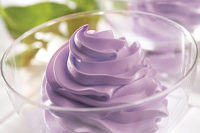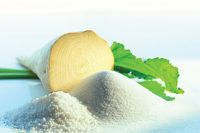Seeing red
The quirks and considerations might best be illustrated by example — which brings us back to that infamous Frappuccino. As Nathalie Pauleau Larrey, color activity manager, David Michael Europe, Valance, France, said, some of the toughest products to color naturally are dairy beverages with a strawberry flavor profile — and, therefore, a red or pink hue.
That’s because in addition to having a high water activity, such beverages are also generally neutral in pH. FD&C Red #40 works splendidly under such conditions but — alas — it is FD&C Red #40.
“Carmine gives a very stable strawberry/raspberry shade that’s perfect to replace Red #40,” Pauleau Larrey noted, but introduces objections of its own, as we’ve already seen. (Among them is carmine’s allergenicity, which prompted FDA to mandate in early 2011 that labels call it out specifically to alert potential sufferers.)
With those two options out of the running, Starbucks might’ve turned to red colorants containing anthocyanin pigments from sources like berries, red cabbage and grape skins. But while these colorants produce appealing strawberry tones similar to carmine when pH is below roughly 4.5 or 5, “the pigments they contain are unstable as pH increases,” Pauleau Larrey said. In a tangy yogurt fruit prep — where the pH is more to anthocyanins’ liking — this is no problem. But in a neutral milk-based beverage, the color may fade or turn bluish, grayish or brownish, making it a deal-breaker.
Enter the carotenoid pigment lycopene, which Starbucks chose as a substitute for carmine following Frappuccino-gate. Extracted from tomatoes, the colorant “is probably the most stable natural red with respect to temperature, and has the widest pH tolerance,” said Roee Nir, color and flavor global commercial manager at LycoRed. He claims it maintains its red tone from pH 2.8 to 8 and can withstand even HTST and UHT pasteurization.
The challenge was that lycopene tends toward the orange and yellow range of the red spectrum, but Jonas noted that manufacturers learned to alter the compound’s crystalline structure to yield a red with bluer undertones.
“You wind up blending different crystalline structures and sizes to control and modify it,” he said. The result is that the patented form of lycopene designed for the application has “opened up whole new ranges of colors that the ingredient can achieve.”
Nir is quick to note that processors can achieve the appearance of not only berries but fruits like watermelon. “For other dairy products, we can fit colors, including not just lycopene but beta carotene, too, to give a peach tone to peach yogurt, or a yellow color for pineapple. We can go well beyond berry,” he said.






